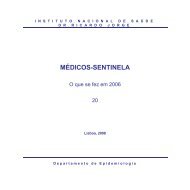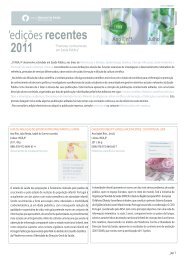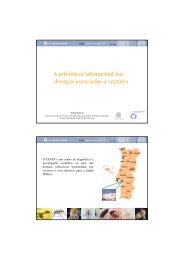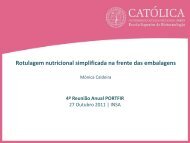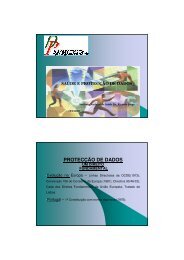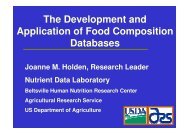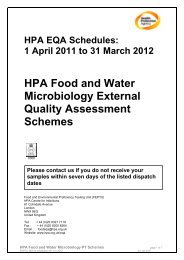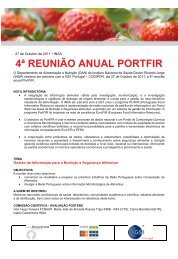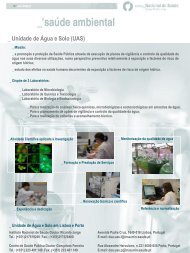European Society of Mycobacteriology - Instituto Nacional de Saúde ...
European Society of Mycobacteriology - Instituto Nacional de Saúde ...
European Society of Mycobacteriology - Instituto Nacional de Saúde ...
Create successful ePaper yourself
Turn your PDF publications into a flip-book with our unique Google optimized e-Paper software.
PP-36<br />
FITNESS COST OF Mycobacterium tuberculosis CLINICAL<br />
ISOLATES RESISTANT TO FLUOROQUINOLONES<br />
VON GROLL, Andrea 1 ; MARTIN, Anandi 1 ; JUREEN, Pontus 2 ; HOFFNER, Sven 2 ; PORTAELS, Françoise 1 ; PALOMINO,<br />
Juan Carlos 1 ; ALMEIDA DA SILVA, Pedro 3<br />
1 - Institute <strong>of</strong> Tropical Medicine, Antwerp, Belgium<br />
2 - Swedish Institute for Infectious Disease Control, Solna, Swe<strong>de</strong>n<br />
3 - Universida<strong>de</strong> Fe<strong>de</strong>ral do Rio Gran<strong>de</strong>, Rio Gran<strong>de</strong>, Brazil<br />
Fluoroquinolones (FQs) have been used as effective second-line drugs in the treatment <strong>of</strong> the tuberculosis. However, the<br />
emergence <strong>of</strong> M. tuberculosis resistant to FQs has contributed for the occurrence <strong>of</strong> XDR-TB. This study investigated the<br />
fitness cost related to the mechanism <strong>of</strong> resistance to FQs in M. tuberculosis clinical isolates. A total <strong>of</strong> 37 isolates had<br />
the <strong>of</strong>loxacin, moxifloxacin and gatifloxacin susceptibility <strong>de</strong>termined by the proportion method and were sequenced<br />
to look for mutations in gyrA and gyrB. The role <strong>of</strong> efflux pumps was evaluated by <strong>de</strong>termining the minimal inhibitory<br />
concentration <strong>of</strong> the FQs in the presence and absence <strong>of</strong> verapamil by resazurin microtiter assay. Growth curves <strong>of</strong> the<br />
isolates were obtained using the MGIT960 automated system and the lag phase time and rate <strong>of</strong> growth were established<br />
to compare the fitness. On the 25 FQ resistant isolates (FQ R ), the most frequent mutation was at Ala-90→Val, followed<br />
by mutations at Asp-94 to Gly, Tyr, Ala and Asn. Some unusual mutations were i<strong>de</strong>ntified at Asp-89→Asn, Asn-533→Thr<br />
(gyrB) and <strong>de</strong>letion <strong>of</strong> the codon 678 and 679 in gyrB. The isolate with mutation at Asn-533→Thr was the only case <strong>of</strong><br />
no whole cross resistance among the three FQs tested. One FQ R isolate was wild type for the region investigated. The<br />
efflux mechanism was in<strong>de</strong>ntified in 36% <strong>of</strong> the FQ R isolates, being more frequently found in moxifloxacin and gatifloxacin.<br />
In regard to the fitness parameters, the mutation at Asp-94 showed a longer lag phase while the mutation at Asn-90 had<br />
not any significant difference related to the wild type FQ S . The establishment <strong>of</strong> FQ R isolates without fitness cost warns<br />
for the possibility <strong>of</strong> a continue emergence <strong>of</strong> XDR-TB and highlights for a more rational use <strong>of</strong> FQs, not only for the<br />
treatment <strong>of</strong> TB, but also, for other bacteria.<br />
108 ESM 2009



